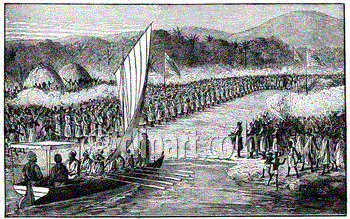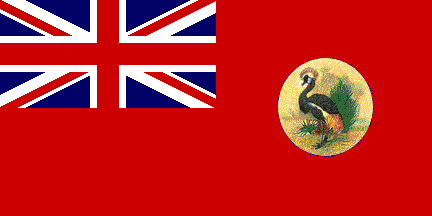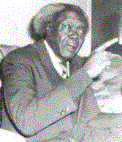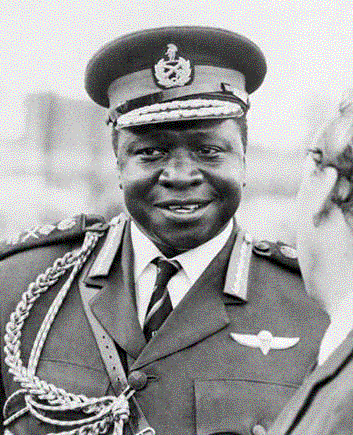|
|  |

|
| precolonial Uganda |
By recounting Ugandas history, it enables one to gain perspective on Ugandas present day cultural diversity and unremitting situation, particularly HIV/AIDS. Its very history may lead to root causes of the unimaginable crises that has claimed the lives of thousands of Ugandans.
Early History
Ugandas history dates back to circa 500 b.c. when Bantu-speaking people migrated into South-West Uganda. By the 14th Century, Uganda was organized in several kingdoms, known as the Cwezi states composed of Nilotic-speaking Lwo people (from present South-Eastern Sudan). Around 1500, the Lwo people established the Bito dynasties of Buganda, Bunyoro, and Ankole. Later in the 16th century, additional Lwo-speaking peoples were formed, the Alur and Acholi ethnic groups, and then conquered northern Uganda.
Bunyoro was the leading state of southern Uganda during the 16th and 17th Centuries, controlling a locality stretching into present-day Rwanda and Tanzania. Buganda was expanding. By 1800, Buganda controlled a large territory spanning from the Victoria Nile to the Kagera River. Regional administrators were appointed by kabaka (king), and maintained a large bureaucracy, as well as a powerful army. |
 |

|
| Ugandan colonial flag |
The Colonial Era
In 1862, the first European to visit Buganda was John Hanning Speke, a British explorer who discovered Lake Victoria. Speke met with Mutesa, the present kabaka in Uganda, and agreed to a proposal to allow Christian missionaries to enter his territory. In 1884, kabaka Mutesa died and was succeeded by kabaka Mwanga. Carl Peters was the next significant European to visit Uganda. In 1899, Mwanga signed a treaty of friendship with the German colonialist. By 1890, Great Britain and Germany signed a treaty that in part, gave the British rights to what was to become Uganda.
By 1894, Great Britain officially made Uganda a protectorate. Mwanga, however, began to oppose the escalating power of the British, when the British began to rule Uganda through Buganda. Thereafter, Mwanda was overthrown and replaced with his infant son, Daudi Chwa. By negotiating treaties and using force where necessary, from the late 1890s to 1918, the British established their authority in the remaining areas in Uganda.
In 1900, an agreement was signed with Buganda that gave the kingdom considerable autonomy and also transformed it into a constitutional monarch controlled largely by Protestant chiefs.
In 1904 Ugandas economy commenced and the commercial cultivation of cotton went underway. It soon became a major export crop; coffee and sugar production followed. From the 1905s and onward, many Asians (Indians, Pakistanis, and Goans) began to settle in Uganda, where they played a leading role in the countrys commerce.
An Independent Nation
On 9 October 1962, Uganda became an independent country under the rule of A. Milton Obote as prime minister; and Buganda in turn was given considerably autonomy. Mutesa was elected president in 1963, when Uganda became a Republic. Dominated by the struggle between the central government and Buganda, in its first years of independence, Obote in 1966, introduced a new constitution ending Bugandas autonomy. By 1967 the central government gained power and divided Buganda into four districts.
| Apollo Milton Obote |

|
| click here for more information |
|
 |
|
 |
|
 |
|
|
| Maj. Gen. Idi Amin |

|
| click here for more information |
Amins Reign of Terror
In January 1971, Obote, at the time outside the country, was deposed by Major General Idi Amin. Although Amin was faced with fierce opposition from the army, by officers and troops loyal to Obote, by the end of 1971 Amin managed to take firm control of the army and ultimately the country. In August 1972, Amin made a decision and ordered all Asians who were not citizens of Uganda to leave the country. Within three months, 60,000 had left for Great Britain.
Amins rule became increasingly more autocratic and brutal; it is estimated that over 300,000 Ugandans were killed during the 1970s. His corrupt and arbitrary system of administration (i.e., replacing civilian cabinet with military cabinet) exacerbated its rifts in the military, which led to a number of sudden and decisive changes of government illegally.
Interestingly, in 1976 Amin declared himself president for life and Uganda claimed portions of west Kenya. Uganda invaded Tanzania in 1978 in attempt to occupy the Kagera region. A successful counter invasion launched by Tanzania unified anti-Amin forces under the Uganda national liberation Front (UNLF), consequently driving Amins forces out and ultimately leading Amin himself to flee the country.
In the Wake of Amin : the Aftermath of Amins Rule
Tanzania left an occupation force in Uganda which participated in the looting of Kampala (presently the capital of Uganda). After Amin, Uganda experienced a flux of presidents, changing from Yusufu Lule and then replaced by Godfrey Binaisa. The UNLF, suffering from internal strife, was swept out of power by Obote and his party, the Uganda Peoples Congress. In the early 1980s, approximately 200,000 Ugandans sought refuge in neighboring Rwanda, Zaire, and Sudan.
When the National Resistance Army (NRA) was not given a role in the new regime, it continued its guerilla campaign, and captured Kampala in 1986. Yoweri Museveni, however, became the new president. Despite the efforts of rival military groups, Museveni has been able (with the help of foreign aid) to begin stabilizing the country and rebuilding the shattered economy. Museveni has also brought much attention to national reconciliation and restoration of human rights.
Although the political situation appears to be stabilized, Ugandans continue to suffer. Since the 1980s, AIDS has claimed the lives of many Ugandans and in 1991 Uganda reported more cases than any other African nation. It will be clear that Ugandas history of low economy, civil strife; its flux of presidents, etc. has contributed to and aggravated the prevailing nature of HIV/AIDS.
| President of Uganda : Yoweri Kaguta Museveni |

|
| click here for more information |
|
|
|  |

